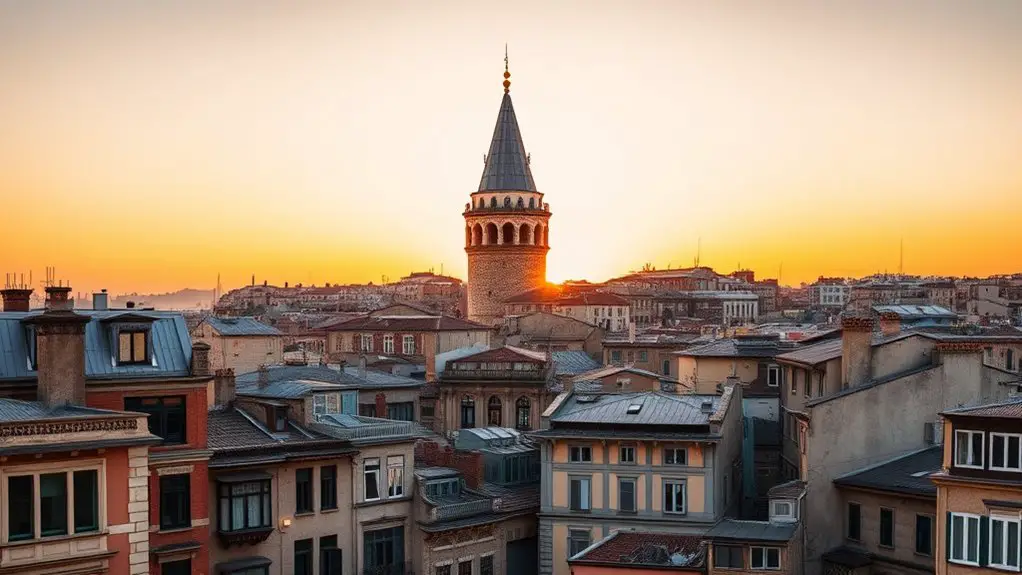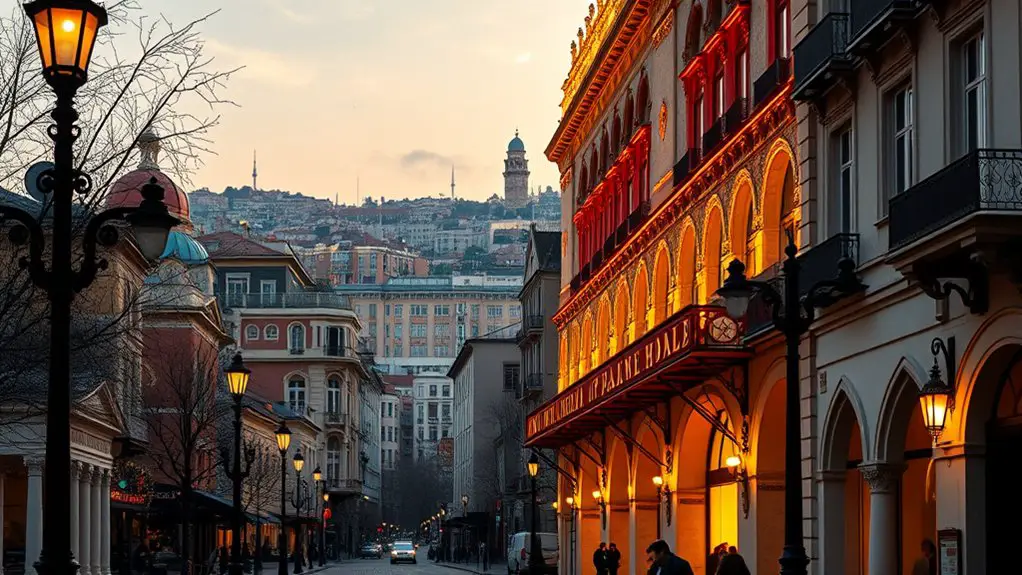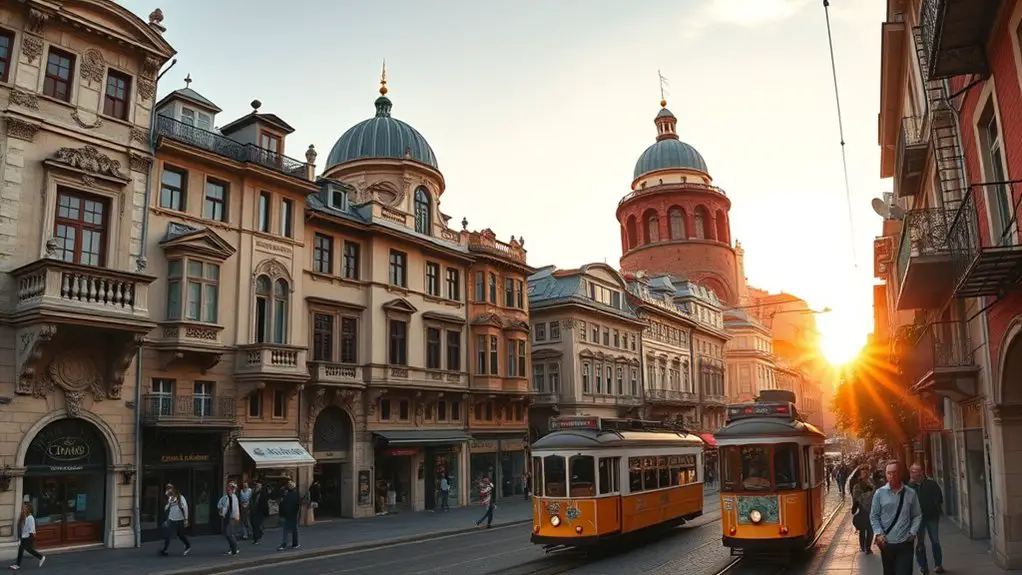Beyoglu stands like an open book, its pages filled with stories etched in stone and mortar. Each architectural landmark reveals layers of history, reflecting the district’s transformation from the Ottoman Empire to today. The Galata Tower, Istiklal Avenue, and the Pera Palace Hotel are not just structures; they’re witnesses to time’s passage. As you explore these sites, you’ll uncover how they intertwine tradition with modernity, prompting questions about the narratives they hold.
Key Takeaways
- Beyoglu’s architectural landmarks, like the Galata Tower, illustrate the resilience and historical evolution of Istanbul over centuries.
- Istiklal Avenue connects various historical sites, showcasing the transition from the Ottoman Empire to contemporary urban life.
- The Pera Palace Hotel represents luxury from the late 19th century, reflecting the cultural and social dynamics of its era.
- Ottoman architecture in Beyoglu features grand domes and intricate tile work, symbolizing the empire’s aesthetic and functional design principles.
- Modern developments adapt historic buildings into vibrant spaces, merging tradition with innovation while preserving the area’s cultural essence.
The Galata Tower: A Symbol of Resilience

As you stroll through the bustling streets of Beyoglu, the Galata Tower stands tall, a monument to the resilience of Istanbul’s architectural heritage. This iconic structure, built in the 14th century, embodies Galata history, reflecting the neighborhood’s diverse cultural influences.
Originally a watchtower, it has witnessed the city’s evolution, symbolizing both protection and connectivity. The tower’s conical shape and sturdy stonework evoke a sense of permanence amidst the changing urban landscape.
Standing at 66.9 meters, it commands attention and offers a panoramic view of Istanbul, reinforcing its role as a beacon throughout the centuries.
As you admire its impressive silhouette, consider the symbolism it carries. The Galata Tower represents not just a physical landmark but also a demonstration of the resilience of a city that has continuously adapted and thrived.
In many ways, it mirrors Istanbul itself—ever-evolving yet steadfast in its rich history.
Istiklal Avenue: The Heartbeat of Beyoglu

Istiklal Avenue pulses with the energy of Beyoglu, serving as the vibrant artery that connects the past with the present. This iconic street isn’t just a thoroughfare; it’s a canvas reflecting the cultural significance of the area.
As you stroll along, you’ll encounter historic buildings that narrate the evolution of Istanbul, from the Ottoman Empire to modern times. You can’t ignore the echoes of historical events that have unfolded here, from political rallies to artistic movements, each leaving an indelible mark on the city’s identity.
The avenue attracts diverse crowds, blending locals and tourists, each seeking a slice of Beyoglu’s rich tapestry. Cafés, shops, and galleries line the street, fostering a communal spirit where creativity thrives.
In essence, Istiklal Avenue isn’t merely a place; it’s a living history book that invites you to explore and engage with the dynamic heartbeat of Beyoglu.
The Historic Pera Palace Hotel: a Glimpse Into Luxury

Stepping into the Historic Pera Palace Hotel is like entering a time capsule of luxury and elegance. This iconic establishment, opened in 1895, offers you a unique glimpse into the grandeur of a bygone era.
As you walk through its ornate halls, you’ll notice the intricate design and opulent furnishings that speak to a rich history of hospitality. The Pera Palace was a favorite among famous guests, including Agatha Christie, who penned “Murder on the Orient Express” during her stay.
Every corner of the hotel reflects a commitment to providing a luxury experience, from the lavish dining options to the meticulously maintained rooms.
You can almost feel the whispers of the past as you explore its storied architecture. The Pera Palace isn’t just a hotel; it’s a celebration of history where elegance meets modern comfort, making it a must-visit for anyone seeking a taste of luxury.
The Architectural Influence of the Ottoman Empire
While exploring the architectural landscape of Beyoglu, you’ll quickly notice the profound influence of the Ottoman Empire woven into its structures. Ottoman architecture showcases a unique blend of functionality and aesthetics, characterized by intricate tile work, grand domes, and spacious courtyards. These elements reflect not just the empire’s engineering prowess but also its rich cultural heritage.
Here’s a visual representation of key features:
| Architectural Feature | Description |
|---|---|
| Domes | Symbolize heaven, offer grandeur |
| Minarets | Used for calls to prayer |
| Courtyards | Promote social interactions |
| Tile Work | Display intricate artistry |
As you wander through Beyoglu, you’ll feel the presence of these features, reminding you of the Ottoman legacy that continues to shape the city’s identity and charm. This architectural influence is a tribute to a vibrant cultural heritage that remains alive today.
Modern Developments: Blending Tradition With Innovation
As you explore Beyoglu’s modern landscape, you’ll discover a fascinating interplay between tradition and innovation that defines its contemporary architecture.
This vibrant district showcases adaptive reuse, where historic buildings are transformed into trendy cafes, galleries, and residences, preserving their cultural essence while providing new purposes. For instance, the conversion of old warehouses into creative spaces illustrates how Beyoglu embraces its past while encouraging urban revitalization.
You’ll notice striking contrasts between classical facades and sleek, modern designs, creating a unique aesthetic that resonates with both locals and visitors.
This blending enhances Beyoglu’s character, fostering a sense of community and encouraging social interaction. As you wander through its streets, you’ll appreciate how these architectural choices reflect a commitment to sustainability and heritage, creating a dynamic environment that respects the past while looking boldly towards the future.
In Beyoglu, tradition and innovation truly coexist, enriching the urban experience.
Frequently Asked Questions
What Is the Best Time to Visit Beyoglu for Sightseeing?
The best time to visit Beyoglu for sightseeing is during the shoulder seasons of spring (April to June) and fall (September to October).
You’ll avoid the peak tourist season, which can get crowded and pricey. Visiting during off-peak times lets you enjoy milder weather, shorter lines, and a more authentic experience with local culture.
Plus, you might find better deals on accommodations and dining, making your trip even more enjoyable.
Are There Guided Tours Available for Beyoglu’s Architectural Landmarks?
Yes, there are several guided tour options available that focus on Beyoglu’s architectural significance.
These tours often highlight the stunning blend of styles found in the area, from neoclassical to modern designs.
You’ll explore iconic landmarks while knowledgeable guides share fascinating stories behind each structure.
Participating in one of these tours not only enhances your understanding of Beyoglu’s architectural heritage but also enriches your overall sightseeing experience.
Don’t miss out!
How Accessible Are Beyoglu’s Landmarks for Individuals With Disabilities?
Beyoglu’s landmarks are increasingly accessible, like a modern smartphone in an ancient library. You’ll find accessible transportation options near most sites, ensuring smooth travel.
Landmark design often incorporates ramps and elevators, making your visit easier. However, some older buildings might still pose challenges due to their historical nature.
What Local Cuisine Should Visitors Try While in Beyoglu?
When you visit Beyoglu, you’ve got to try local dishes like kebabs, mezes, and baklava.
The vibrant food markets, like the famous Galata Bridge area, offer a feast for your senses. You can sample fresh simit, enjoy flavorful street food, or sip on Turkish tea while soaking in the atmosphere.
Each bite tells a story, reflecting the rich culinary heritage of the region. Don’t miss out on the delicious offerings that define Beyoglu!
Are There Any Annual Festivals or Events Celebrated in Beyoglu?
When it comes to local culture, you’re in for a treat!
Beyoglu hosts vibrant festivals and cultural events throughout the year. The Istanbul Jazz Festival brings music lovers together each summer, while the Beyoglu Culture Road Festival showcases art and performances, celebrating the area’s rich heritage.
You’ll find that these events not only entertain but also deepen your appreciation for the local culture, making them a must-see during your visit.
Conclusion
As you explore Beyoglu’s architectural landmarks, you can’t help but wonder: how do these structures shape our understanding of history? From the resilient Galata Tower to the vibrant Istiklal Avenue, each building tells a story of cultural evolution. The luxurious Pera Palace Hotel invites you to experience a bygone era, while modern innovations harmoniously blend with tradition. Together, they create a dynamic narrative that not only preserves Beyoglu’s rich heritage but also invites you to be part of its ongoing journey.
